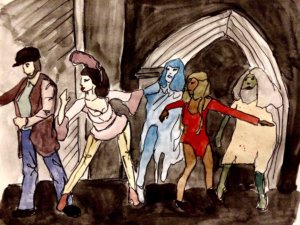Thomas Morgan Jones of Theatre New Brunswick applies techniques from across the globe
“Frustration is a kind of tension, isn’t it?” Thomas Morgan Jones asked at one point during his workshop last weekend. “It’s a tension in your mind. Let it go because it’s really not useful.” He then gave a cue by whacking a thick bamboo stick against the ground; the students moved into the next position.
Despite the winter weather, Jones, Theatre New Brunswick’s artistic director, travelled to Sackville to share his training. To three current students and two alumni, he taught a five-hour workshop on the Suzuki Method of Actor Training and the Viewpoints methodology.
Before starting on exercises, Jones provided the history of the method, developed by Tadashi Suzuki and his actors in Toga, Japan. Suzuki “seeks to heighten the actors’ emotional and physical power and their commitment to every moment onstage,” Jones explained.
This is done by “returning the wholeness, or the totality, of the human body back into the theatre” through intense focus on energy creation, breath control and controlling one’s centre of gravity. This method provides alternative to typical post-20th century acting techniques that focus primarily on internal thought and text. Alison Crosby, an alumna who travelled from Halifax, said in an email that she was excited to learn more about Suzuki, which she’s “been curious about for a long time.”

“It’s rare to find workshops that are intensives in such specific forms of theatre training, so travelling two hours to and back from Sackville was more than worthwhile,” she wrote.
For most of the workshop, Jones led the attendees through several precise and demanding Suzuki moves, which required each actor to create a “fiction” or mental image to build focus. He would first perform and explain the exercise, allow everyone to try it together, provide notes and corrections, and finally give students the chance to watch and perform for each other.
These exercises were taxing, both physically and mentally. One of the most demanding required sustained focus while moving at a measured pace from standing straight to a squatting position, coming to complete stillness, then back up again. Notes were given while legs wobbled from the burn. The amount of time to move shortened between each set of moves before Jones moved to cuing a change in position with a sharp sound from the bamboo stick.
“It was perhaps more challenging than I had initially expected,” Crosby wrote, “but this kind of intense and immersive introduction is, in my experience, the most effective way to learn.”
Between beats and notes, Jones challenged students to embrace the obstacles presented by Suzuki.
“Move toward the difficulty, master it, and then, because you’re an artist, immediately identify the next difficulty and move towards that,” he said. “That’s how we grow.”
After a break, Jones and the attendees returned to explore theatrical Viewpoints, a methodology based on Mary Overlie’s original Viewpoints, which are used in dance. This training focuses on an actor’s relationship with time through tempo, duration, kinesthetic response and repetition. There is also a focus on space through shape, gesture, architecture, spatial relationship and topography.
“A lot of Viewpoints is really noticing,” Jones explained. “It’s noticing what’s already there and how that can be a part of your work and how you can make it a part of your work.”
The attendees observed the Motyer-Fancy Theatre as a group, naming everything they could see that drew their attention. This included elements such as orange extension cords, symmetry in metal bars, shadows and salt stains on the theatre floor.
Students then explored the space as different genres of instrumental music played. To strings, they worked together to both find harmony and create discord while playing with speed. To a polka, one explored solitude and repetition, squatting and moving in straight lines. Two worked together in floorwork while a piano melody played; two others chased each other in circles, playing with distance to techno beats.
“Surprise yourself,” Jones said about these improvisations. Some moments were predictable, and he challenged students to “amp it up and then keep going past what you think you know as opposed to what’s safe.”
This wisdom is one of the reasons Crosby viewed the workshop as worthwhile. She wrote, “The chance to learn from him for a few hours was like a small glimpse into the work he uses to create the theatre he does, which is endlessly fascinating to hear about and witness.”





